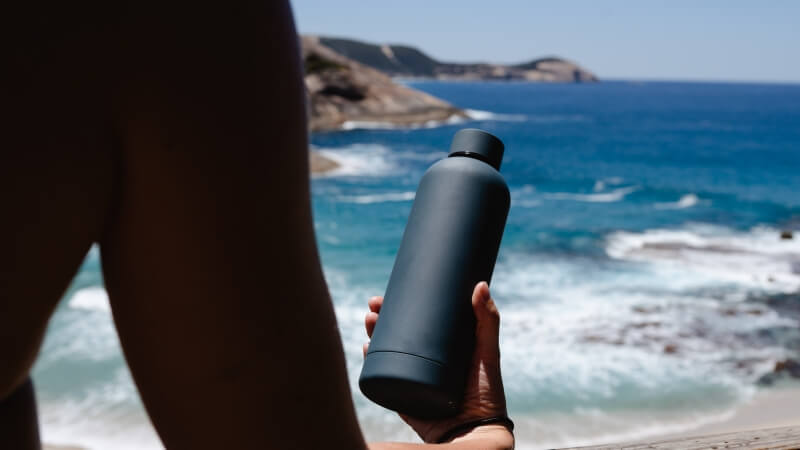
Gym Essentials For Women:A Complete List
Enthusiasts who never miss a session, understanding the gym essentials for women is crucial, not just for what to wear but also for what to

While it’s possible to disinfect water bottle for repeated use, they can become a breeding ground for bacteria and mold. But what’s the best way to clean a water bottle while making sure it’s safe to drink from?
Here, we present the most effective methods to disinfect your drinking bottles, ensuring they are free from harmful organisms.
To properly disinfect a water bottle, consider using solutions like hydrogen peroxide, vinegar, baking soda, or a bleach mixture. Alternatively, water bottle cleaning tablets or homemade disinfecting wipes are also effective options. After applying these solutions, it’s important to rinse the bottle completely and allow it to air dry.
Moisture inside drinking bottles can promote bacterial growth. While a dishwasher can remove visible dirt from a water bottle, thorough disinfection is key to eliminating harmful bacteria.
Smart water bottles are extremely useful. Yet, regardless of their practicality, it’s important to clean them regularly, particularly when they’re used outdoors. Develop a routine of disinfecting water bottles by employing these techniques.
Sometimes, even after a thorough cleaning with soap and water, a water bottle might retain some slime or unpleasant smell. In these situations, hydrogen peroxide is an effective disinfectant.
First, rinse the bottle with hot water, then add about 1/4 cup of hydrogen peroxide. Secure the cap, shake the bottle well, and then rinse it out with warm water.
Given that the food industry frequently uses 35% food-grade hydrogen peroxide to eliminate bacteria and microorganisms in food packaging, using hydrogen peroxide to disinfect water bottles is both effective and safe.
To disinfect, you use either chemicals or acidic agents to eradicate harmful organisms in a water bottle. As a natural cleaning agent, vinegar, with its 5% acetic acid content, is excellent for eliminating common household bacteria.
Once you’ve cleaned the bottle with soapy water and rinsed it, fill it with a mix of equal parts white vinegar and water. Shake it a few times and let the mixture sit in the bottle overnight. In the morning, rinse the bottle well with warm water to wash away any remaining vinegar.
Using a diluted vinegar solution is particularly effective for stainless steel water bottles or smart water bottles, as the vinegar effectively removes bacteria without harming the bottle’s material. For a more concentrated approach, you can apply vinegar directly onto a sponge or paper towel and scrub the bottle thoroughly.
Throughout a typical day, you come into contact with objects such as doorknobs or your phone, and may inadvertently touch your mouth with your hands. These same hands are often used to open your water bottle, potentially transferring germs to the bottle’s rim where your lips make contact.
Research indicates that everyday habits can lead to the accumulation of up to 300,000 colony-forming units of bacteria per square centimeter on your water bottle. Yet, through effective cleaning and simple disinfection methods like using baking soda, these infectious bacteria can be eliminated.
Baking soda’s granules provide gentle yet effective abrasion, making it safe for use on stainless steel water bottles without scratching. For tougher grime and mildew, a baking soda and water solution acts as a stronger disinfectant.
To use, add 2 tablespoons of baking soda to your bottle and fill the rest with water. Shake the mixture well. This solution can also be used to clean the bottle cap or straw. Let it sit overnight and then rinse thoroughly with warm water.
If remnants of dirt or odor persist, incorporate a vinegar solution to tackle the more stubborn organic matter. The acidic nature of vinegar reacts with baking soda, producing carbon dioxide gas that helps dissolve contaminants.
For water bottles that are dishwasher-safe, consider running them through a dishwasher cycle for additional cleaning before drying.
For those who dislike the scent of vinegar or bleach, cleaning tablets offer an alternative solution for disinfecting water bottles. Simply fill the bottle with water, add a tablet, give it a good shake, and let it sit for 30 minutes. Once rinsed and dried, your bottle is ready for use again.
Water bottle cleaning tablets are convenient to use, dissolving in water to create effervescent bubbles that effectively combat dirt and odors. The ingredients in most cleaning tablets typically include baking soda and hydrogen peroxide, which are natural and efficient for both cleaning and odor removal.
Disinfecting wipes are a great option when you don’t have immediate access to running water, such as during outdoor activities or while hiking with your water bottle.
You can find disinfecting wipes in stores, or you can easily make them at home using common household items.
To create your own, mix 4 teaspoons of bleach with 32 fluid ounces of water in a plastic or glass container. Depending on the size and absorbency of your towels, you may need to adjust the proportions.
Put cloth or paper towels in another container and pour the bleach solution over them, ensuring they are fully saturated for at least 5 minutes.
Alternatively, if bleach is unavailable, mix 60% to 90% ethanol or isopropyl alcohol in a sealable container.
Immerse paper towels or reusable cloths in this alcohol solution.
Allow the wipes to soak for 5 minutes before using.
Wipe down your water bottle with these homemade disinfecting wipes. In situations where you can’t rinse the bottle, consider using alcohol-free wipes to clean it.
How Frequently Should a Reusable Water Bottle Be Cleaned?
It’s recommended to wash reusable water bottles daily with soap and water. Additionally, disinfecting the bottle should be done at least once a week, or more often if you’ve been ill or have taken the bottle outdoors.
What are the Risks of Drinking from a Moldy Bottle?
Drinking from a moldy bottle might not immediately affect healthy individuals, as stomach acid can neutralize common pathogens like mold. However, those with compromised immune systems may experience symptoms such as nausea, cramps, or diarrhea after consuming from a mold-contaminated bottle.
To disinfect water bottle is crucial for maintaining hygiene and health. Regular cleaning with soap and water is a must, but for thorough disinfection, using methods like hydrogen peroxide, vinegar, baking soda, or bleach solutions can be highly effective.
Cleaning tablets and homemade disinfecting wipes offer convenient alternatives. It’s important to keep in mind the type of material your bottle is made of and choose the appropriate cleaning method to avoid damage.
Finally, storing your disinfected water bottle in a dry, clean place ensures it stays safe for use. Following these guidelines will help you maintain a clean and hygienic water bottle, free from harmful bacteria and molds.


Enthusiasts who never miss a session, understanding the gym essentials for women is crucial, not just for what to wear but also for what to

A common myth circulating in the fitness world is the belief that a gym diet plan is unnecessary. Many seem convinced that they can simply

The average bench press, often referred to humorously in gyms as ‘How much ya bench’ or ‘whaddaya bench?’, stands as a quintessential measure of strength

Nowadays, we always seem to be packing a bag for something. Whether it’s getting ready for work with your messenger bag or briefcase, filling up

Enthusiasts who never miss a session, understanding the gym essentials for women is crucial, not just for what to wear but also for what to

A common myth circulating in the fitness world is the belief that a gym diet plan is unnecessary. Many seem convinced that they can simply

The average bench press, often referred to humorously in gyms as ‘How much ya bench’ or ‘whaddaya bench?’, stands as a quintessential measure of strength

Nowadays, we always seem to be packing a bag for something. Whether it’s getting ready for work with your messenger bag or briefcase, filling up
Copyright © 2025 remindsmartbottles. All Rights Reserved.
Copy the coupon code below and fill it in when you purchase to enjoy!
newuser